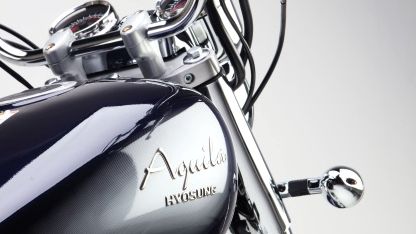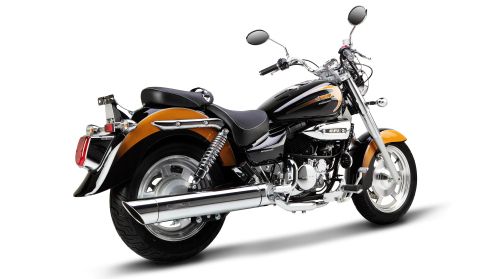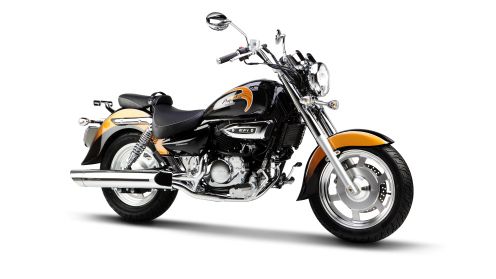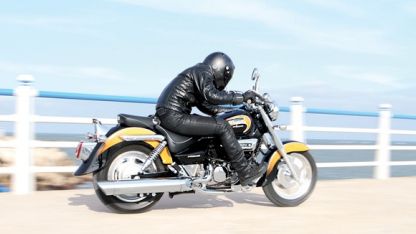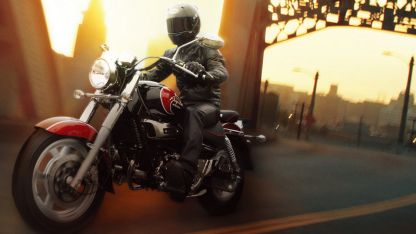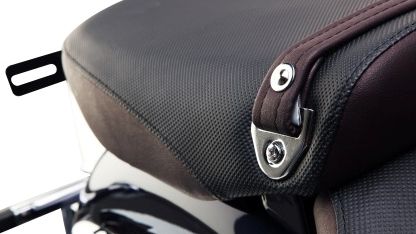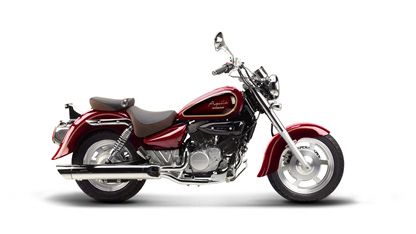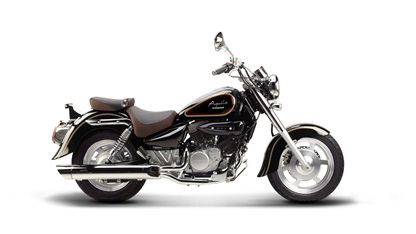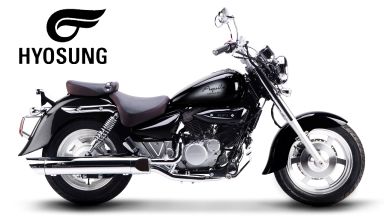The motor division of Hyosung->ke2023 Industries has changed hands a number of times since it started building bikes for Suzuki->ke371 back in '78, and is now under the KR Motors banner producing bikes meant for the U.S. entry-level market as well as its traditional Asian and European territory. Since the new owners are making a concerted push to expand their toehold in the American market, I decided to take a look at some of the products from this little-known (in the West) manufacturer, and the GV250 Aquila, Hyosung's little pocket-cruiser->ke392 model, seemed like a good place to start. Join me while I dissect this Korean concoction like a kimchi/bbq wrap, and see what Hyosung has going on over there.
Continue reading for my review of the Hyosung GV250.
2016 Hyosung GV250
- Make: Array
- Model: 2016 Hyosung GV250
- [do not use] Vehicle Model: Array
Design
While the reinvigorated push into the U.S. market is fairly new, the GV250 seems as though it were built to entice American riders. It carries features that will be familiar to most of us; flared fenders, shrouded forks, a saddle-type seat and V-twin engine. Although the 75-degree layout isn't quite as sexy as a 45-degree mill -- think H-D->ke300 or Indian->ke3292 -- I suppose any V is better than no V at all. As far as the lines go, well I'm just going to go ahead and say it, they are very Rebel->ke3292-esque in its proportions. This similarity is offset somewhat by the fuller fenders on the Aquila versus the bob-and-chop sheet metal on the Honda->ke291 product.
The Aquila runs a low-but-wide, 3.7-gallon fuel tank that flows visually into the wide saddle and stadium pillion pad for an almost Softail-like profile. Although the seat height is rather low at only 27.95-inches high, the width of the saddle increases the apparent distance and makes for a longer trip from hip to ground. The 59.65-inch wheelbase places it in the compact bracket, and at only 388 pounds wet, it certainly ranks among the lightest of cruisers. I gotta say some of the chrome looks a little chintzy, and the location of the hot-oxygen sensors in the exhaust pipes could hardly be worse. Not only are they exposed to casual view, but they strike me as being a little vulnerable and the chrome housings just make it ugly to boot. Beyond that, the factory wasn't bashful with the bling, and the Aquila is not without a certain amount of charm.
Chassis
A dual-downtube, double-cradle frame made of mild steel tubing forms the skeleton, and a traditional, yoke-style swingarm made from same material finishes the standing rigging. The steering stem comes set for a 33-degree rake, and the 5.32-inch trail provides a stable and un-twitchy ride, good for keeping newby riders in their comfort zone while not feeling too wooden in the corners. I would be remiss in my duties if I didn't point out the suspension isn't particularly comfortable. The front forks are a little harsh, especially on irregular surfaces, and they don't tolerate much in the way of hard cornering. A pair of coil-over shocks support the rear and come with adjustable preload settings. Granted, it's a light, entry-level bike and as such doesn't rate a top-shelf suspension, so I will call the bouncy bits sufficient at best, and leave it at that.
Cast wheels mount the 110/90-16 front- and 150/80-15 rear hoops. This marks a glaring mistake to mine eyes, and I think the Aquila would look a lot better with a set of laced rims. Plus, given the bargain-basement suspension, I feel like riders would benefit from the little extra bit of “give” associated with tension-spoke wheels. Just sayin', Hyosung.
A single, 275 mm disc and twin-pot caliper binds the front wheel, and an old-fashioned drum slows the rear. Generally, I take a dim view of anything other than a scooter that runs a drum brake, but I make an exception for “full size” bikes with low displacement and weight, especially when the designers were going for a dated look. The brakes are functional, but provide little in the way of “feel” and come sans any sort of ABS or brake-linking features. I'm OK with that given its nature as a beginner's bike, and believe that riders will benefit from a purely analog learning experience without electronic safety nets.
Drivetrain
One of the more interesting aspects of the Aquila concerns the engine configuration. Usually engines this size come in a parallel-twin or even a thumper arrangement, but Hyosung stuffed its 75-degree V-twin into this little ride. Would it look better at 45-to-60 degrees? I'm sure it would. Does it look better than a single or a twingle? You betcha.
Looks aside, the oversquare, 57 mm by 48.8 mm cylinders add up to a total of 249 cc, and the mill uses a combination of cylinder-cooling fins and an oil radiator to dissipate waste heat. Rather than go the easy route, designers opted to use fuel injection to manage the stoichiometric ratio instead of a carburetor, resulting in a friendly engine that responds well to the throttle with little in the way of flat spots and weird zones through the rpm and throttle range.
This little mill cranks out 28.5 ponies, not exactly world-shattering, but certainly sufficient for a trainer/commuter that weighs in under 400 pounds soaking wet. A constant-mesh, five-speed transmission, wet clutch and simple chain drive make the final connection between engine power and pavement. One complaint I hear over and over concerns the rather abrupt nature of the clutch, and the lack of a workable friction zone to offset weak left-hand technique. In short, brand-new riders can probably expect a few herky-jerky takeoffs until their muscle memory gets built up.
Price
Size, weight and ease of operation are all important factors when building entry-level bikes, but I would argue that price is right up there near the top of the list as well. Riders have a tendency to outgrow trainer bikes, sometimes rather quickly, and are faced with trying to either resell at a loss or relegate the bike to garage-ornament status. With that in mind, the pricetag on the Aquila is just right for this sector. The '15 rolled for $3,999 MSRP in black, blue or white, and the factory bumped that up by a mere $100 to $4,099 for the 2016 model year in black, blue or red, and it comes with a one-year warranty on parts and labor, with parts coverage for a second year post sale.
Competitor
Honestly, there's only a handful of small-displacement cruisers out there that come close to the same look as the Aquila, and the most recognized among them would have to be the venerable Honda Rebel, so let's see how they stack up.
At a distance, there are a number of similarities between the two. Both are what I would call “pocket cruisers” with short wheelbases, even shorter seat heights and an upright, cruiser-style seating position. The Rebel wins the limbo contest with a mere 26.6-inch seat height, a bit lower than the almost 28-inch high saddle on the Aquila, and the seat tapers a little to something of a waist at the tank, so none of the “lowness” is soaked up by excess width.
The Rebel also comes off looking a little bit cleaner with understated fenders rather than the almost dresser-like ones featured on the Aquila, a definite case of “less is more.” Honda also stayed the course and stuck to laced rims rather than running cast/mag wheels, a detail that I believe Hyosung would do well to embrace. One tiny detail I would add about the Rebel; it's an old design that has changed little over the years, and it has a rabid fan base with near-infinite accessories and custom parts. So, if you can't unload your “trainer” Rebel when you outgrow it, you can turn it into a custom project bike and continue to get some enjoyment out of it.
While I admit that the teeny-tiny V-twin in the Aquila is a novelty, it doesn't really add much in the way of aesthetic value. In short; neither ride wins, places or shows in the “pretty engine” contest. I also will admit that I've never had to turn a wrench on an Aquila, but the Rebel mill and I are old friends, and I can tell you firsthand that valve adjustments and other routine maintenance tasks are easier on the Rebel than anything else I have worked on. Ever. A definite bonus for folks looking to break into the two-wheeled world without lining the pockets of the local service department for simple repairs.
Hyosung takes the ribbon at the till, barely. At $4,099, it's barely less expensive than the $4,190 Rebel by almost a bill, but I don't expect that to drag anyone looking at a Rebel across the fence. Honda enjoys quite a bit of name recognition, and the Rebel has been a favorite for many years. That kind of established base can be hard to overcome, especially in such a niche market.
He Said
“Gotta admit, I kind of liked the Aquila at first until I got to know it a little better. I'm a little put off by some of the fitment issues; namely that many of the fasteners do not seem to be seated properly/squarely, which makes me question everything that I can't see within the cases as well. You might be tempted to say “well, it's just a trainer bike,” but I would point out that my Rebel was over a decade old when I bought it, I was the third owner and it still ran like a top when I sold it to its fourth owner a year later, so “entry-level” does not necessarily always equate to “disposable.” To be honest, I would be surprised to see an Aquila put in that kind of service record under the same conditions.”
She Said
My wife and fellow writer, Allyn Hinton, says, “I was a bit intrigued when TJ told me that he was looking at a 250 cc bike with a V-twin. I wanted to like it, I really did. I just can't. The small engine doesn't bother me; I'm rather warming up to the 700-and-lower engine sizes, but the whole bike just seems cheap. Looking at the GV250, it doesn't look like everything exactly fits and it looks like nothing is tight even when it is. You expect it to go rattling down the road as you go. Now, I know the price is economical, but damn. I am not a Honda fan -- though as a mechanic, I must admit they are some of the easiest to work on -- but I would have to recommend the Rebel over the GV250. When you're haggling with the Honda salesman, don't tell him you're considering a GV250 if he can't bring the price down on the Rebel. He'll laugh at you and then raise the price. That said, if you can get one for a nice price and you don't mind treating it like a disposable bike, go for it.”
Specifications
|
Engine: |
|
|
Type: |
Air / Oil cooled DOHC 8-valve 75° V-twin |
|
Displacement: |
249cc |
|
Bore x Stroke: |
57 x 48.8 |
|
Compression: |
10.3 : 1 |
|
Fuel System: |
Fuel injection |
|
Lubrication: |
Wet sump |
|
Transmission: |
|
|
Clutch: |
Wet, Multiplate |
|
Gear: |
Constant Mesh 5-speed |
|
Final Drive: |
Chain |
|
Chassis: |
|
|
Overall Length: |
89.84 inches |
|
Overall Height: |
43.15 inches |
|
Overall Width: |
34.45 inches |
|
Wheel Base: |
59.65 inches |
|
Seat Height: |
27.95 inches |
|
Brake, Front: |
Single disc, 2 pistons caliper |
|
Brake, Rear: |
Drum |
|
Suspension, Front: |
Conventional Telescopic |
|
Suspension, Rear: |
Swing arm with Hydraulic Double shock absorber (Preload adjustable) |
|
Tires: |
|
|
Front: |
110/90 -16 |
|
Rear: |
150/80 -15 |
|
Fuel Tank Capacity: |
3.7gal |
|
Curb Weight: |
388lbs |
|
Warranty: |
2 Year Limited, 1st year parts & labor, 2nd year parts |
|
Colors: |
|
|
2015: |
Black, Blue, White |
|
2016: |
Black, Blue, Red |
|
Price: |
|
|
2015: |
$3999 |
|
2016: |
$4099 |
|


